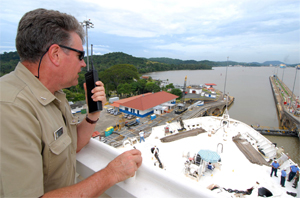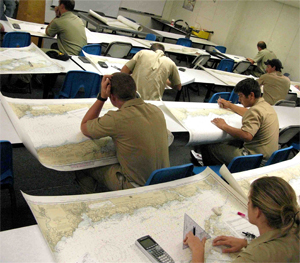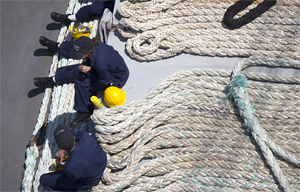The increasingly sophisticated and regulated maritime world needs professionals with stronger skill sets than in the past. But accumulating those skills through dedicated and accredited programs may start to get more difficult. With a strong economy keeping demand high on the water, and with the challenge growing to become an instructor at many maritime training institutions, the potential for a shortfall is real.
Capt. Ed Nanartowich, president and chief operating officer at Mid-Atlantic Maritime Academy in Norfolk, Va., said the obstacles for schools include finding the right people to fill positions, which can vary geographically, and matching instructors to the particular curriculum offered by an institution.
“Instructors, the good ones that is, are special people who have an affinity to pass on their knowledge to other mariners and want to have those mariners succeed in their jobs at sea,” he said.
It boils down to several universal issues for all schools trying to find and retain high-quality instructors, according to Nanartowich:
• The economy is booming, and there are jobs aplenty in many related maritime and non-maritime industries.
• The “baby boomer” generation is about to retire or has retired and, in many cases, wishes to remain so. “Getting them to re-engage with maritime subjects can be daunting when they are set on putting bait on hook and watching the sunset in warm climes,” he said.
• Financial compensation for instructors is considerably less than for their seagoing counterparts. A mariner, young or older, can easily find a full-time job that pays twice the wage of a typical instructor, Nanartowich said. And yet the skill set required for instructors is high, with new International Maritime Organization (IMO) requirements for curriculum.
• The complexities of the required training have grown within the IMO and within the National Maritime Center (NMC) by default, which makes it difficult to find instructors who meet competency mandates.
Nanartowich said revenues at maritime institutions often do not allow for instructors’ wages to compete with those earned on the water, making it a less attractive opportunity for a retired or transitioning mariner.
“The fix to that, you may say jack up the prices of the courses so you can pay the instructors more, but then the mariners (taking the courses) take the brunt of the expense,” he said. “They pay enough already, and in my opinion too much, particularly at the unlicensed levels.”
While he admitted that might be an odd comment for the president of a maritime school to make, “I am a mariner first and I know what their issues are since they were my very same issues when I went to sea,” Nanartowich said.
 |
|
Capt. Ed Nanartowich communicates with his crew while transiting the Panama Canal in July 2007 aboard the hospital ship USNS Comfort. Nanartowich, who served as civilian ship-master on the Military Sealift Command vessel, is now president of Mid-Atlantic Maritime Academy. The path to becoming an instructor is open to many retiring or transitioning mariners, but few are taking it. |
|
U.S. Navy photo |
Making it worthwhile
As in any job, instructors need to see a future, said Dan Weinstock, professor and chairman of the Marine Transportation Department at California Maritime Academy. Employees need to feel valued and respected, he said, adding that he was lucky “in that I was hired into a tenure track position.”
Weinstock started his long maritime career as a shell fisherman on Long Island’s Great South Bay when he was in sixth grade. He stuck with that until he was 23 years old, when he “hung up his clam rake” to go to Cal Maritime. He has a long resume of on-the-water experiences that led to an instructor position at the academy in 1996, sailing as the chief officer on the training ship Golden Bear for eight summers and as the relief master on three cruises.
“I won’t debate the pros and cons of tenure, but I will say that at least in the California State University system, (with a tenure track) one can see the timeline clearly,” Weinstock said. “Full promotion into CSU is an 11-year process. Tenure is not just handed out.”
Maritime schools need dedicated faculty who will strive to get better in the classroom, he said, because it takes time to get comfortable in front of 50 students hungry for knowledge.
“All the experience in the world, in many cases, does not prepare someone to stand in front of a classroom and convey information in an organized and thoughtful manner,” Weinstock said, adding that most people must learn how to teach. “We have classes that meet 45 times over a 15-week semester. Being prepared for all those lectures can be a daunting task, especially during the beginning of a career or when the information is new to the faculty member.”
Even someone with little practical maritime experience can be very successful in a classroom, he said. But instructors must be prepared, be willing to do the necessary research in preparation for the classroom, and maintain control of their students.
Donald Maier, dean of the School of Maritime Transportation, Logistics and Management at Cal Maritime, said there also are other responsibilities and opportunities for faculty.
“Most people don’t realize that there’s a lot more to the job than just teaching. There is a service aspect to the institution and also a scholarship piece,” he said. That side of the job is important to the community and also ensures that faculty doesn’t become stagnant.
The proverbial bottom line
According to Weinstock, schools don’t need to be able to pay a potential instructor “maritime industry wages” — especially in areas such as San Francisco Bay, where housing can be prohibitively expensive — but they do need to offer an attractive wage and attractive working conditions.
“People do not go into education expecting to get wealthy, but they do need to be able to survive on their wages,” he said.
For example, someone who is considering a career change and has small children at home initially may be comfortable with the wage being offered, but they may soon discover that most of their check goes to covering child care. “Of course, this is a problem in many industries,” Weinstock said.
Those concerns are shared by Jerry Achenbach, superintendent of Great Lakes Maritime Academy in Traverse City, Mich., who also cited the recent loss of two instructors to retirement. Achenbach said the once-affordable housing in the area is disappearing due to a growing market for vacationers.
 |
|
Cadets pursuing a degree in marine transportation get down to business at California Maritime Academy. Finding instructors is becoming more challenging amid a perfect storm of a strong economy, “baby boomers” reaching retirement age, and a growing wage gap with instructors’ seafaring colleagues. |
|
Courtesy California Maritime Academy |
Is there a solution? Achenbach thinks the academic system works, but more organizations need to provide a tenure track and incentives so more individuals are willing to invest their time and effort to join a maritime faculty.
Nanartowich believes the need for maritime skills is great, and he questions whether government-supported schools that receive Maritime Administration (MarAd) funding can do it alone. He said Mid-Atlantic Maritime Academy, which does not get funding from MarAd, could benefit from that kind of help so tuition can be kept at a reasonable level.
“Every person that crosses our threshold here has one goal in mind, namely to go down to the sea on ships,” he said. “Modest funding to non-state schools by federal programs that are concerned with, for example, the maritime workforce response in a national surge event, would rapidly grow the licensed and unlicensed reserves.”
Stopping the turnover
High employee turnover hurts all industries, Weinstock said. At maritime schools, the lack of tenure-track faculty opportunities hurts recruitment and retention and can lead to turnover. That’s because lecturer positions typically pay less than tenured ones and, as a result, a lecturer may not see a future and leave shortly after arriving.
“It isn’t fair to the students to have a revolving door of faculty, (and) it takes most faculty a few years to get comfortable in the classroom,” he said.
Any specialized field requires laser-focused faculty, and maritime instructors all have to develop areas of expertise, Weinstock said. The challenge of finding someone to teach a few sections of a highly specialized course compounds the issue.
“Who is going to work part time and teach only a few times a week, and according to our schedule, while making very little money?” he said.

